Instructions to Candidates
- Write your name and index number in the spaces provided above
- Sign and write the date of examination in the spaces provided.
- Answer all questions in this paper
- In question 4 choose any two of the questions numbered (a), (b), (c) and (d)
- DO NOT remove any pages.
- This paper consists of 11 printed pages
- Candidates should check the question paper to ensure that all the pages are printed as indicated and no questions are missing.
For Examiners Use Only
|
Section |
Question |
Maximum Score |
Candidate’s Score |
|
A |
1a |
09 |
|
|
1b |
06 |
||
|
2 |
15 |
||
|
B |
3 |
14 |
|
|
4 |
14 |
||
|
5 |
10 |
||
|
6 |
10 |
||
|
7 |
06 |
||
|
C |
8 |
16 |
|
|
Grand Total |
100 |
|
|

QUESTIONS
SECTION A: BASIC SKILLS
-
- Continue the given opening to make a melody of 16 bars for voice. Modulate to the Dominant before returning to the tonic. Incorporate dynamic variations. Add phrase marks. (9 marks)
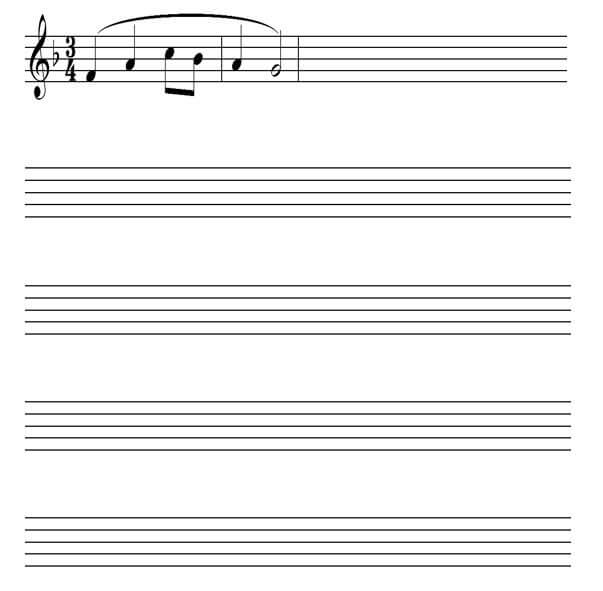
- Using staff notation, compose a tune to suit the following lyrics. Add phrase marks. (6 marks)
‘Singing, dancing and making merry; Lads and lasses in joyous pleasure,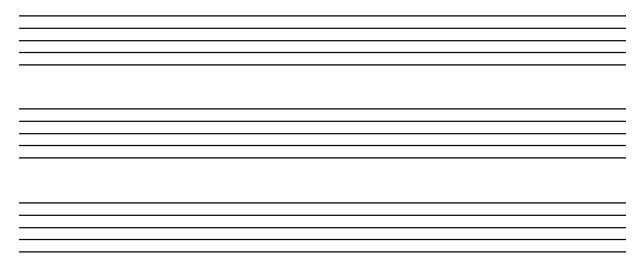
- Continue the given opening to make a melody of 16 bars for voice. Modulate to the Dominant before returning to the tonic. Incorporate dynamic variations. Add phrase marks. (9 marks)
- Copy and harmonize the given melody for Soprano, Alto, Tenor and Bass (SATB). Choose appropriate chords from the following; I, ii, IV, V and vi. Use a passing six four. Indicate the chords that you use. (15 marks)
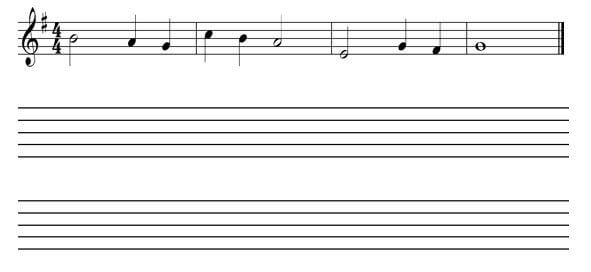
SECTION B: HISTORY AND ANALYSIS (48 marks)
- AFRICAN MUSIC
- Identify each of the following Kenyan instruments: (4marks)
Arupepe - ..……………………………………………………………………………
Embegete - ………..……………………………………………………………………
Tuonik - …………………………………………………………………………….
Mwazigizi - …………………………………………………………………………….. - Name three Kenyan dances that acquire their names from the instruments that accompany them. (3 marks)
- State any three roles of Music in an initiation ceremony. (3 marks)
- Differentiate between a lyre and a fiddle. (4 marks)
- Identify each of the following Kenyan instruments: (4marks)
- WESTERN MUSIC
Answer any two of the questions (a), (b), (c) and (d).- William Byrd
- During which period of Music History did William Byrd live? (1 mark)
- Why is William Byrd referred to as the King of English Music? (2 marks)
- Outline any two events that Byrd held jointly with Tallis. (2 marks)
- Outline two appointments held by Byrd during his musical career. (2 marks)
- Haydn Franz Joseph
- State two duties he performed while in Esterhazy. (2 marks)
- Name any two of his symphonies. (2 marks)
- What stood out about the Emperor String Quartet by Haydn. (1 mark)
- Outline any two influences on Haydn’s musical career. (2 marks)
- Franz Liszt
- What was Franz Liszt’s Nationality? (1 mark)
- Give one example of Liszt’s symphonic poem. (1 mark)
- Outline any two early influences on his musical career. (2 marks)
- Name any three works by Liszt. (3 marks).
- Bela Bartok
- State the three areas in Music which Bela Bartok specialized in. (3 marks)
- Outline any two influences on Bela Bartok’s composition. (2 marks)
- Identify the following works by Bela Bartok. (2 marks)
- The wooden Prince - ..……………………………………………………..
- Bluebeard’s Castle - ………………………………………………………
- William Byrd
- Prescribed Traditional African Music Chivoti by Diwani Nzaro from Youtube.
- Name the media in the recording (2 marks)
- State any two roles of the melodic instrument in the recording. (2 marks)
- Outline any three characteristics of African Music evident in this work. (3 marks)
- Describe the beginning of the performance in the recording. (3 marks)
- Prescribed Western: Too Much I Once Lamented: by Thomas Tallis
-
- What type of work is “Too Much I Once Lamented”? (1 mark)
- Give a reason for your answer in (i) above. (1 mark)
- State the media of this work. (2 marks)
- Using bar numbers, identify four stylistic features used between bars 1 to 34. (4 marks)
- Identify the dynamics used in this work. (2 marks)
-
- Unprepared Analysis
Study the music extract below and answer the questions that follow.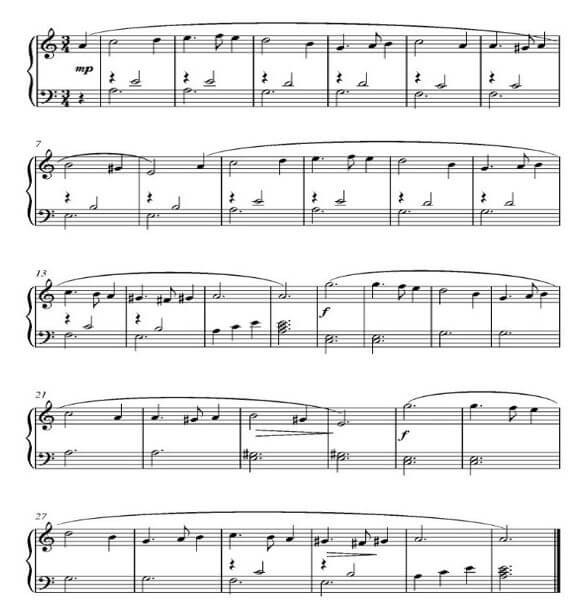
- By use of bar numbers, identify the form of this work. (2 marks)
- For what instrument is this music scored? (1 mark)
- Name the tonic key of this music. (1mark)
- Name the key to which the music modulates at bar 17. (1 mark)
- Write any two commonly used rhythmic motifs in the melody. (1 mark)
SECTION C: GENERAL MUSIC KNOWLEDGE (16 marks)
-
- Translate the following melody from staff to sol-fa notation. (4 marks)

- Define the following musical terms (4 marks)
- Ostinato
- Symphony
- A tempo
- Passion
-
- State any two roles of a producer in the Music industry. (2 marks)
- State four steps to consider before sight reading a piece of Music. (2 marks)
- Transpose the following music a Major 3rd up. (4 marks)
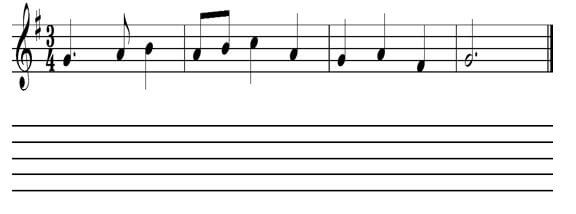
- Translate the following melody from staff to sol-fa notation. (4 marks)

MARKING SCHEME
SECTION A: BASIC SKILLS
-
- Continue the given opening to make a melody of 16 bars for voice. Modulate to the Dominant before returning to the tonic. Incorporate dynamic variations. Add phrase marks. (9 marks)

- 16 Bars- 1 mark
- Correct Modulation- 2 marks
- Lyricism- 2marks
- Dynamic Var - 1mark
- Phrasing- 2 marks
- Cadences- 1 mark (Final and any other)
- Using staff notation, compose a tune to suit the following lyrics. Add phrase marks. (6 marks)
‘Singing, dancing and making merry;Lads and lasses in joyous pleasure,- Syllabic division- 1 mark
- Accentuation- 1 mark
- Lyricism- 2 marks
- Cadences – 1 mark (Final and any other)
- Phrasing- 1 mark
- Penalise if not indicated
Key signature- ½ mark
Time signature- ½ mark
- Penalise if not indicated
- Continue the given opening to make a melody of 16 bars for voice. Modulate to the Dominant before returning to the tonic. Incorporate dynamic variations. Add phrase marks. (9 marks)
- Copy and harmonize the given melody for Soprano, Alto, Tenor and Bass (SATB). Choose appropriate chords from the following; I, ii, IV, V and vi. Use a passing six four. Indicate the chords that you use. (15 marks)

- Each correct chord ½ mark – 5 marks
- Cadences - 2mark
- Chord progression- 2 marks
- Brace, bar lines- 1 mark
- Voice leading- 1 ½ marks
- Voice range -1 ½ marks
- Passing six-four- 2 marks
- AFRICAN MUSIC
- Identify each of the following Kenyan instruments: (4marks)
- Arupepe - A horn from Iteso community
- Embegete - A single headed drum from Kuria community
- Tuonik - A cowbell from Sabaot community
- Mwazigizi - A single stringed fiddle from the Taita community.
- Name three Kenyan dances that acquire their names from the instruments that accompany them. (3 marks)
- Isukuti dance
- Mabumbumbu dance
- Peke dance
- Shiriri dance
- Chepkon’go
- State any three roles of Music in an initiation ceremony. (3 marks)
- Encourage the initiates to be brave
- Mock cowards
- Educate the initiates on their new roles in the society after the ceremony
- Educate the community on the culture passed down from generation to generation
- Entertain the gathering
- Any other correct answer
- Differentiate between a lyre and a fiddle. (4 marks)
- A fiddle has 1 or 2 strings while a lyre has 6-8 strings
- Most fiddles are played by bowing while most lyres are played by plucking
- A fiddle is smaller in size then the lyre
- A fiddle is played while being held under the arm while lyres are placed between the legs on the ground while playing
- Any other correct answer
- Identify each of the following Kenyan instruments: (4marks)
- WESTERN MUSIC
Answer any two of the questions (a), (b), (c) and (d).- William Byrd
- During which period of Music History did William Byrd live? (1 mark)
- Renaissance Period
- Why is William Byrd refered to as the King of English Music? (2 marks)
- He established English music genres that other composers emulated/ followed.
- Developed the English madrigal
- Wrote virginal and organ music that that elevated the English keyboard style.
- Composed a great deal of Church music to English lyrics
- Outline any two events that Byrd held jointly with Tallis. (2 marks)
- Was co-organist with Talis at the Royal chapel
- Jointly granted the monopoly to import, print, publish and sell music and music paper. (accept any of the events)
- Outline any two appointments held by Byrd during his musical career. (2 marks)
- Organist and master at the Lincoln Cathedral
- Gentleman of the Royal Chapel
- During which period of Music History did William Byrd live? (1 mark)
- Haydn Franz Joseph
- State two duties he performed while in Esterhazy. (2 marks)
- He was assistant music director.
- He was Kapellmeister.
- Composed symphonies, operas, operattas, masses, chamber music and dance music.
- He rehearsed and conducted performances of his own and other’s works.
- Coached singers
- Settled disputes among musicians in his charge.
- Name any two of his symphonies. (2 marks)
- Surprise
- Military
- Clock
- Drum roll
- London
- What stood out about the Emperor String Quartet by Haydn. (1 mark)
- It provided the melody for the national anthems of both Germany and Austria
- Outline two influences in Haydn’s musical career. (2 marks)
- Wolfgang Amadeus Mozart considerably influenced Haydn in symphonic technique.
- Other composers e.g. C.P.E Bach who influence him in writing symphonies and sonatas in 3 movements.
- Influenced by the concertos of Antonio Vivaldi.
- When he visited London, he was inspired by the works of G.F. Handel.
- State two duties he performed while in Esterhazy. (2 marks)
- Franz Liszt
- What was Franz Liszt’s Nationality? (1 mark)
- Hungarian
- Give one example of Liszt’s symphonic poem. (1 mark)
- A Faust Symphony
- Outline any two influences on his early music training. (2 marks)
- His father Adams Liszt who taught him piano at the age of five.
- His teacher Carl Czerny at Vienna.
- His friend Frederick Chopin
- Name any three works by Liszt. (3 marks).
- Oratorios: Die Legende von der heiligen Elisabeth and Christus
- Symphony: A Symphony to Dante’s Divina Commedia
- 12 symphonic poems, A Faust Symphony
- Piano concerto, in E-flat, A major and E-flat
- Piano Sonata: piano sonata in B Minor
- Rhapsody: Hungarian Rhapsody No. 2 in C-Sharp Minor
- Mass: Hungarian Coronation Mass
- What was Franz Liszt’s Nationality? (1 mark)
- Bela Bartok
- State the three areas in Music which Bela Bartok specialized in. (3 marks
- Composition
- Performance (piano)
- Ethnomusicology
- Outline any two influences on Bela Bartok’s composition. (2 marks)
- His mother taught him piano formally by the age of 5 years
- His teachers like Istyan Thomas (piano and composition)
- His contemporaries like Zoltan Kodaly who researched folk music with him, Richard Strauss
- Music of his predecessors like Claude Debussy, Johannes Brahms
- His tours to different countries in Europe where he collected folk music and interacted with other composers
- Folk music from Europe and Asia
- Nature and environment he was in at different points of hi career
- Identify the following works by Bela Bartok (2 marks)
- The Wooden Prince- Ballet
- Bluebeards castle- Opera
- State the three areas in Music which Bela Bartok specialized in. (3 marks
- William Byrd
- Prescribed Traditional African Music Chivoti by Diwani Nzaro from Youtube.
- Name the media in the recording (2 marks)
- A Chivoti-flute.
- Two shaken idiophones- one low pitch and a high pitch.
- A struck idiophone-upatsu.
- State any two roles of the melodic instrument in the recording. (2 marks)
- Provides the main melodic tunes hence dictate the musical form.
- Pitches the performance
- Enriches the music texture.
- Outline any three characteristics of African Music evident in this works. (3 marks)
- The main melodic instrument is accompanied by other percussive instruments hence enhances the performance in the presentation.
- The music is polyrhythmic; emphasis is laid to the vitality and variations of the many underlying rhythms.
- The music depicts an implied call-response style either in the melodic instrument itself or between the melodic instrument and the percussive section.
- Describe the beginning of the performance in the recording . (3 marks)
- The music begins with the struck idiophone-upatsu followed by the low pitch shaken idiophone with is immediately followed by the melodic instrument-chivoti and finally the second high pitched shaken idiophone follow suit in a syncopated rhythm.
- Name the media in the recording (2 marks)
- Prescribed Western: Too Much I Once Lamented: by Thomas Tallis
-
- What type of work is Too Much I Once Lamented? (1 mark)
- Ballet
- Give a reason for your answer in (i) above. (1 mark)
- It has a fa-la-la-la refrain
- What type of work is Too Much I Once Lamented? (1 mark)
- State the media of this work. (2 marks)
- Choral work scored for soprano 1, soprano 2, alto, tenor, and bass.
- Using bar numbers, identify four stylistic features used between bars 1 to 34. (4 marks)
- Word painting: bar 15-22 on the word ‘tormented’, bar 49-58 on the word ‘wringing’.
- Upward scalic movement: bar 24- 33 on the bass line.
- Sequence: bar24-25 is sequenced at 26-27 on the bass.
- Imitation: bar 28-29 on the bass imitated at bar 30-31 on the alto.
- Melismatic: bar 4-7 on the tenor.
- Repetition: bar 73 repeated at bar 74 on the bass.
- Identify the dynamics used in this work. (2 marks)
- mf- bar 1-12
- f – bar 13-20, 30-35, 59-62, 70-77
- dim- bar 21-23
- mp- bar 23-25,63-65
- cresc.- bar 26-29, 51-58,66-69
- p-bar 36-50
-
- Unprepared Analysis
Study the music extract below and answer the questions that follow.
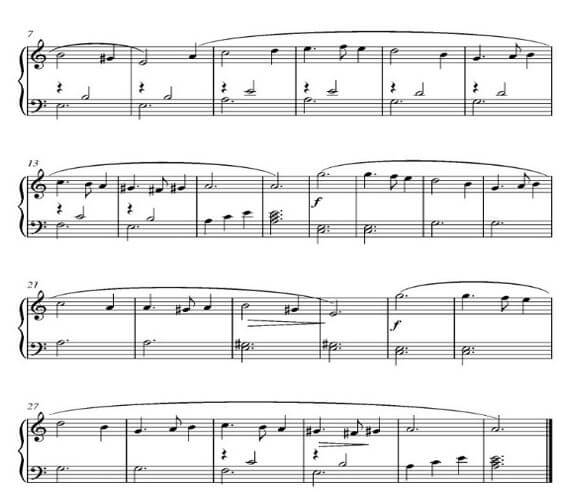
- By use of bar numbers, identify the form of this work. (2 marks)
- The music is in binary form (AB)
- Bar 1 to 16 forms the first section A, while bar 17 to 32 forms the second section B
- For what instrument is this music scored for? (1 mark)
- Scored for keyboard (Piano)
- Name the tonic key of this music. (1mark)
- The tonic key of this music is A minor
- Name the key to which the music modulates to at bar 17. (1 mark)
- The music modulates to the relative major key C major
- Write any two commonly used rhythmic motifs in the melody. (1 mark)
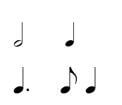
- By use of bar numbers, identify the form of this work. (2 marks)
-
- Translate the following melody from staff to sol-fa notation. (4 marks)

- Doh is F major
- Beat= Crotchet
- 4{|m:-.f:m.r:d.t,|d.,r:m.f:r:-|d.t,:l,.t,:d:t,|d:-:-:-||}
- 4
- Define the following musical terms (4 marks)
- Ostinato
- A short musical phrase or melody that is repeated over and over, usually at the same pitch
- Symphony
- A major work for an orchestra usually composed in four movements, at least one of which is in sonata form.
- A tempo
- Go back to the original speed.
- Passion
- A type of oratorio telling the story of Jesus Christ’s crucifixion.
- Ostinato
-
- State any two roles of a producer in the Music industry. (2 marks)
- Records the raw music
- Edits the music
- State four steps to consider before sight singing/ Reading a piece of Music. (2 marks)
- Key signature
- Time signature
- Range
- Rhythm
- Any leaps that require attention
- performance directions
- Dynamics
- State any two roles of a producer in the Music industry. (2 marks)
- Transpose the following music a Major 3rd up. (4 marks)
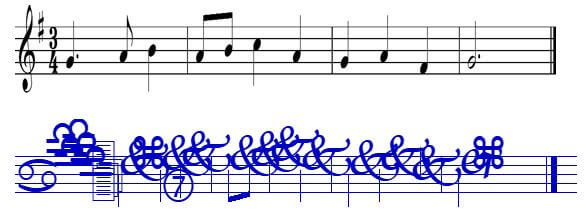
- Translate the following melody from staff to sol-fa notation. (4 marks)
Download Music Paper 3 Pre Mock Questions and Answers - Mokasa I Joint Examination July 2021.
Tap Here to Download for 50/-
Get on WhatsApp for 50/-
Why download?
- ✔ To read offline at any time.
- ✔ To Print at your convenience
- ✔ Share Easily with Friends / Students

